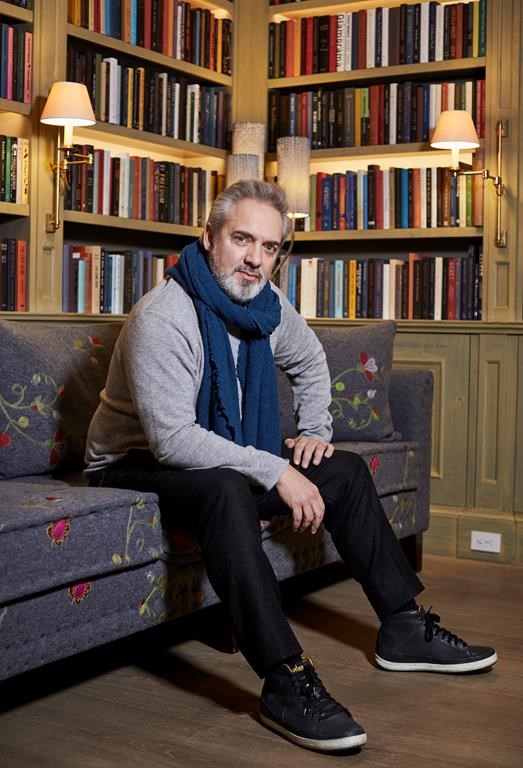Q&A: Sam Mendes on making ‘1917’ in one long take

Posted December 20, 2019 9:38 am.
NEW YORK — After the juggling act of two Bond films, with their cadre of characters and armoury of gadgets, Sam Mendes had something cleaner in mind for his next film.
Two main characters. No backstory. Real time. And one shot.
From the start, Mendes envisioned his “1917” as unfolding continuously and breathlessly. In the British trenches of World War I, two soldiers are tasked with delivering an urgent message to stop an attack, planned for the next morning, that’s doomed to fail.
The Germans have stealthily retreated. Mendes, working with cinematographer Roger Deakins and production designer Dennis Gassner (both collaborators from Mendes’ 007 epic “Skyfall”), follows their harrowing journey without blinking, hiding any edits to give the impression of a ceaseless and fluid film.
For even the 54-year-old Mendes, renowned for his inventive stagings (he won a Tony earlier this year for directing “The Ferryman” and this March will bring “The Lehman Trilogy” to Broadway), it’s an especially bold enterprise, one that extends the cinematic history of the long take (see “Rope,” “Russian Ark,” “Birdman,” among others) into a new realm.
Before “1917” lands in select theatres Christmas Day and expands wide January 10, Mendes discussed why he hopes people are drawn in by his technical achievement but, as soon as the lights go down, forget it.
___
AP: You opened “Spectre” with a great long take. Is that when you started thinking about more elastic ways to shoot?
Mendes: That was one I was really proud of and enjoyed, as well. I loved the process of doing it. It asks you to think of the multiple ways a camera can tell a story that are not close-up, close-up, over-the-shoulder, over-the-shoulder, two-shot, push-in through the door. I found myself quite quickly defaulting to standard ways of telling a story. Just coverage, coverage and more coverage. The challenge here was to make it on the day and not in post. You feel like everyone’s making it on the day because everyone knows there’s no way out of this. This is the movie. And every single member of every department is engaged on every shot. Normally, it’s like, “Well, we’re in close-up so special effects can go have some breakfast. And now we’re on a shot of a building blowing up, the hair and make-up isn’t so important.” But here, everyone was engaged in every second of the film. It happened at the beginning of “Spectre.” Everyone was maxed out, and I love that feeling.
AP: Were you concerned that it could come off like a gimmick?
Mendes: We experience life as a single shot. We go through life with one unbroken take. It’s editing that’s the gimmick. Editing is a wonderful tool if you want to jump time, jump space, jump from one story to another. But editing is so overused in just a basic scene. You and me talking, we would have already used five or six different set ups. You have to ask yourself: Why is that now our default?
AP: How extensive was the rehearsal?
Mendes: The difference between this and a normal movie is that the actors started prep with the crew. We couldn’t build anything or judge anything until we had physically rehearsed the journey we were going to take. Everything started on empty fields with scripts in hand, planting flags for the trenches and no man’s land. This is the distance, this is where the trenches cross, etc. Then you extrapolate that onwards through vast areas of land. Only then could we start digging the trenches, and we dug over a mile of trenches and filled them with people. Every step of the journey was accounted for.
AP: “1917” is designed to be seen on the big screen. How much do you think about a movie today having to compete with streaming?
Mendes: I’ve made franchise movies but I’ve also made movies on a much, much smaller scale that would today probably be on a streaming service, and would be fine on a streaming service. What I did want to do, though, was make a film where the audience went, “Oo, I’ll be missing out if I didn’t see this in a cinema.” But I don’t think there’s that thing that used to happen where pretty much everyone who made a story with a beginning, middle and end that lasted two hours thought it as their God-given right to be on a big cinema screen. That’s no longer the case. You have to fight for that.
AP: You once compared your experience making two Bond films to “a siege.” Would you ever make a franchise film again? I imagine you’re conscious that in the time of one Bond film, you could have directed three plays.
Mendes: Exactly. Or maybe five. I think my franchise years are probably over. Never say never — excuse the pun. I learned a whole amount. It was a great adventure. But I think that in the end, the feat of engineering sometimes overwhelms the human element of storytelling. And it’s the human element of storytelling that interests me the most.
AP: “1917” is dedicated to your grandfather, Alfred Mendes, who was a runner in WWI. What prompted you to return to him now?
Mendes: The winds that were blowing before the First World War are blowing again. It was 100 years ago almost to the day that I started writing. The danger is that war is being gradually forgotten. Those that lived through it and fought in it are dead. These men were fighting for a free and unified Europe, which right now would be worth remembering in my country, perhaps. So, there is a sense there’s something unsettled in the air, the shifting of borders, the obsession with nation over universal good. I thought it was time to be reminded of that and also make a movie that’s not defined by its nation. It’s about the human experience of war.
___
Follow AP Film Writer Jake Coyle on Twitter at: http://twitter.com/jakecoyleAP
Jake Coyle, The Associated Press








